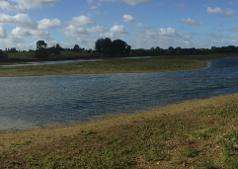A partnership between Cranfield University, The Parks Trust and the Environment Agency will measure the environmental effects of restoring areas of floodplain forest habitat.
The floodplain forest is currently being re-created in the Ouse Valley Park in Milton Keynes through a joint venture between The Parks Trust and Hanson Aggregates.
The scheme will create a rich and varied wetland ecosystem, an environment that is rare due to centuries of human modifications to our rivers and floodplains. By re-creating an area of back channels in the river floodplain, the area will resemble natural conditions and over time will develop into a varied habitat supporting a diversity of wildlife. The research project is investigating the environmental effects and benefits of the scheme to guide the management of the floodplain forest as it develops, demonstrating the contribution this type of habitat restoration makes to the environment.
Natalia Perez Linde, Cranfield PhD researcher, is undertaking detailed research into environmental factors such as ground water levels, soil type, water quality and vegetation, to identify which species of plant will grow in what conditions. She commented: "The first part of the research has considered the hydrology of the area, identifying how much water needs to enter the floodplain for certain types of vegetation to flourish. This can be managed through a series of back channels or the positioning of features such as gravel banks."
Phil Bowsher from The Parks Trust added: "Cranfield's research will help us identify the best way to manage the floodplain forest to develop into a diverse wildlife habitat which the local community will be able to experience and enjoy. We also want to understand the full environmental effects of the scheme and to ensure the research and what we learn from our project in the Ouse Valley are shared with others considering similar schemes elsewhere."
The research outputs are expected to be available in 2015, however, as Natalia adds; "Ecosystems are dynamic. Species need a number of years to establish and the ecosystem needs time to settle. The guidelines will set out a framework that will enable others to quantify the success in further floodplain restoration projects."
Provided by Cranfield University























